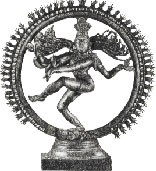Chidambaram Natarajar Temple. Lord Shiva, Govindaraja Perurmal. Sivan Koil. Famous Temples in Tamilad.
 |
• Bogi Pongal : Fri, Jan 14, 11 • Pongal : Sat, Jan 15, 11 • Kanu Pongal : Sun, Jan 16, 11 • Thai Poosam : Thu, Jan 20, 11 |
|
|
You are here: Home » Tamilnadu Temples » Chidambaram » Natarjar KoilChidambara Natarajar Temple Located in the temple town of Chidambaram, 78 km south of Pondicherry and 60 km north of Karaikal in Cuddalore District, Chidambaram is one of the five holiest Shiva temples, each representing one of the five natural elements; Chidambaram represents akasha (aether). Akasa Lingam is embodiment of Shiva as the "formless Space". Shiva is worshipped in the "formless form" of the Chidambara Rahasyam.
Located in the temple town of Chidambaram, 78 km south of Pondicherry and 60 km north of Karaikal in Cuddalore District, Chidambaram is one of the five holiest Shiva temples, each representing one of the five natural elements; Chidambaram represents akasha (aether). Akasa Lingam is embodiment of Shiva as the "formless Space". Shiva is worshipped in the "formless form" of the Chidambara Rahasyam. The historic temple has Lord Nataraja (Shiva) and Lord Govindaraja Perumal as the presiding dieties. Lord Shiva is depicted in the famous Ananda Tandava or celestial dancing posture. The temple's eastern gopuram or pagoda has all the 108 postures (karnams) of Bharathanatyam sculpted on it. The temple and the Lord were immortalized in the verses of four poet Saints - Thirugnana Sambanthar, Thirunavukkarasar, Sundaramoorthy Nayanar, and Manikkavasagar. Thirunavukkarasar songs are called Thevaram and are sung in the Garbha Graha (Sanctum Sanctorum) of Nataraja. The temple is managed by the Chidambaram Dikshitar (Deekshitars, the Thillai Three Thousand) - a class of brahmins, who, according to legends, were brought here from Mt. Kailasa by Saint Patanjali specifically for the performance of daily rituals and maintenance of the Chidambaram temple. History of Chidambaram TempleThe origins of this temple is not known. The sangam literature refers to the Chola rulers as great devotees of Nataraja and made several endowments to the temple. This tradition was followed by the Pandyas and the Vijayanagar rulers. The various architectural styles seen in the temple - Chola, Pandya, Pallava, Vijayanagara, and Chera - are testimony to the continual patronage to the temple by different dynasties.How to get to Chidambaram?Chidambaram is in Cuddalore district, 40 km from Pondicherry. It is 240 km south of Chennai, well connected by train and bus routes.Nearest Airport : The nearest airports are in Tiruchirapalli (195 km) and Chennai (245 km). Nearest Railhead : Chidambaram. It lies on the Madras-Tiruchirapalli main line of the Southern Railway. It is connected with Tiruchirapalli, Madras, Madurai (335 km), Rameshwaram (575 km), Bangalore (340 km), and Tirupati (290 km). By Road: Bus services are frequently available from various places in Tamilnadu, Andhra Pradesh, Karnataka, and Pondicherry states to Chidambaram. There are non-stop bus services and express bus services to major cities like Chennai. Local Transport: Taxis and auto rickshaws without meter are available for local transportation. Buses and cycle rickshaws are also available here. View Nataraja Temple in a larger map Temple timings & Pooja KaalamsThere are 6 poojas in a day:
Places to StayHotels In Chidambaram :
Main Utsavams (Festivals) of the TempleA year in the life of men is said to be a single day for the Gods. Therefore, as six poojas are performed in a day, six festivals are celebrated in a year;
Other temples in Chidambaram
Other temples Near Chidambaram
|
|
© 2005-20 Tamilnad.com. All rights reserved. eMail : info@tamilnad.com